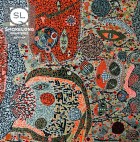This interview with Janssen Cunanan is part of SmokeLong Quarterly’s Global Flash Series. In keeping with the Global Flash Series, the interview is first in Filipino with the English translation following.
Bakit kamote? Ano ang inspirasyon sa kuwentong ito?
Noong 2015, nakausap namin ang isang Lumad na dumayo dito sa Maynila bilang parte ng Lakbayan (isang taunang martsa ng mga katutubo para ikampanya ang karapatan nila sa lupa at sariling pagpapasya). Tinanong namin siya kung anong pinagkakakitaan nila sa kanilang area. Saging, sagot niya. Inilalagay raw nila sa isang sako ang mga saging na napipitas at kinakarga papunta sa bayan. Pagdating dun ay pinapatimbang nila ito. Maswerte na silang makasingkwenta kada sako ng saging. Tinanong namin kung ito yung pinambibili nila ng pagkain. Hindi, ang sagot niya. Yung singkwenta pesos ay pinambibili raw nila ng gamot at iba pang mga medical supplies. Nagtaka kami. Ano, ‘ka ko, ang kinakain nila kung nauubos ang kita nila para sa gamot? Sinagot niya ako, kamote.
May mga dagli kang nailimbag sa mga dyornal. Bakit nahiligan mong magsulat nito?
Aksidente ang pagsulat ko ng dagli. Nangyari ito nung sinubukan kong ikwento sa mga katrabaho ko habang nagla-lunch break ang mga ideya ko para sa maikling kwento. Napansin ko ang kapit ng interes nila sa simula ngunit unti-unting kumakawala ang focus nila habang pahaba nang pahaba ang kwento. Kaya sinubukan kong paikliin ang porma nang walang nababawas sa kabuuan ng kwento. At nagustuhan nila ito! Mabilis silang nakakapag-react sa mga kwentong binahagi ko sa kanila. Ito siguro ang isa sa mga kagandahan ng dagli, binibigyan nito ng espasyo ang mga mambabasa na buuin ang tila bitin na kwento.
Malaki rin ang potensyal nito, batay sa sarili kong karanasan, sa pagpukaw ng atensyon ng mga tao para magtanong at kwestiyunin ang mga pangyayari sa kwento ng isang dagli. Sa ganitong paraan, mas nagiging magaan ang pagpapadaloy sa kanila ng impormasyon na kadalasan ay hindi nila nasasagap sa mass media at social media.
Sa ngayon ay tinutuklas ko pa kung ano ang kapasidad ng dagli maging isang anyo ng kritisismo.
Sino o ano ang iyong mga impluwensiya sa pagsusulat?
Bago ako magsulat, madalas kong binabalikan ang mga libro nina Etgar Keret, Kelly Link, Ben Loory, Donald Barthelme, Carmen Maria Machado, Richard Brautigan, Italo Calvino, Nikolai Gogol, Roberto Bolaño, Eduardo Galeano, Inio Asano, Yoshihiro Tatsumi, Shintaro Kago, at Edgardo Reyes.
Pakikuwento ang mga proyektong pinagkakaabalahan mo sa mga panahong ito.
Tinatapos ko sa kasalukuyan ang koleksyon ko ng maikling kwentong pinamagatang Hunyango man ang Tao. Nagsusulat din ako ng screenplay para sa ilang film projects. At tumutulong sa pagbuo ng isang zine, ang Kartilya, na proyekto ng AUX (Artists in BPO Unite for Social Change), isang cultural organization na naglalayong tumindig sa mga isyung kinakahaharap ng mga manggagawang BPO. Lalamanin ng Kartilya zine ang mga kwento, sanaysay, at tula ng mga BPO workers tungkol sa hirap na dinaranas nila sa loob ng BPO industry.
***
What’s with the specificity in the use of kamote (sweet potato)? What’s the inspiration behind this story?
In 2015, we talked to a member of a Lumad tribe who came here to Manila as part of a mass movement initiative called Lakbayan (an annual indigenous peoples’ march to call attention to ancestral land rights and self-determination). We asked him for his region’s source of livelihood. Banana, he said. They placed the bananas they had picked in a sack, lugged them for delivery to the city. The bananas were then weighed upon arrival in the city. If they [the banana-picking indigenous people] got lucky, which rarely happened, they could earn up to 50 pesos [approximately one U.S. dollar] per sack of bananas. We asked him if the money earned this way was used for buying food. He said no. The fifty pesos was spent for medicine and other medical supplies. This confused us. So we asked him what they ate if all the money they had earned was spent on medicine. He told me, kamote.
You have flash fiction pieces published in various journals. What’s in flash fiction that you find appealing?
My first foray into writing flash fiction happened by accident. One time during a lunch break, I tried to tell my coworkers about my idea for a short story. I noticed they were attentive only at the start, and both their interest and focus waned as my narrative went on. So, I thought of compressing the form without taking out anything from my story. And they liked it! They also reacted faster to my stories. This is probably one of the charms of flash fiction; it gives readers the mental space to complete what may otherwise sound like a seemingly incomplete story.
I also saw, from experience, its huge potential for provoking readers’ attention so they end up asking about what’s happening in the story. This way, it becomes much easier to impart information usually not available via mass media and social media.
For now, I am trying to find out flash fiction’s capacity as a form of criticism.
Who or what are your writing influences?
Before I write, I usually go back to the books of Etgar Keret, Kelly Link, Ben Loory, Donald Barthelme, Carmen Maria Machado, Richard Brautigan, Italo Calvino, Nikolai Gogol, Roberto Bolaño, Eduardo Galeano, Inio Asano, Yoshihiro Tatsumi, Shintaro Kago, and Edgardo Reyes.
Tell us about your current projects.
I am finishing Hunyango man ang Tao (Even if Humans Are Chameleons), my collection of short stories. I am also writing screenplays for my film projects. And I’m helping finish a zine called Kartilya, a project of AUX (Artists in BPO Unite for Social Change), a cultural organization that aims to stand with BPO workers on issues they are facing. The contents of the Kartilya zine are BPO-worker-written stories, essays, and poems about the difficulties of working in the BPO industry.



 The core workshop of SmokeLong Fitness is all in writing, so you can take part from anywhere at anytime. We are excited about creating a supportive, consistent and structured environment for flash writers to work on their craft in a community. We are thrilled and proud to say that our workshop participants have won, placed, or been listed in every major flash competition. Community works.
The core workshop of SmokeLong Fitness is all in writing, so you can take part from anywhere at anytime. We are excited about creating a supportive, consistent and structured environment for flash writers to work on their craft in a community. We are thrilled and proud to say that our workshop participants have won, placed, or been listed in every major flash competition. Community works.